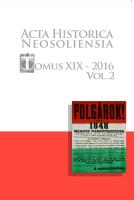Prejavy štátnej a národnej identity na príklade osláv 15. marca
v mestách Zvolenskej a Liptovskej župy
na konci 19. a začiatku 20. storočia
Manifestations of state and national identity on the example of 15th March
celebrations in the towns of Zvolen and Liptov county
in the late 19th and early 20th century
Author(s): Alica KurhajcováSubject(s): History
Published by: Filozofická fakulta Univerzity Mateja Bela
Keywords: national identity; historical memory; 15th March celebrations; towns of Zvolen county; towns of Liptov county
Summary/Abstract: The ruling class of Hungarians and people affected by Magyarization seized the Hungarian urban public space from the last third of the 19th to the early 20th century. It was a result of the official hungarian policy of Magyarization. The national holidays, anniversaries and commemorative days were celebrated in the intentions of that policy and ideology of the Hungarian nation state. In relation to the non-Magyars they reflected the superiority of the Hungarian-Magyar historical memory and simultaneously they were deleting other national memories (also Slovak one). This fact affected the possibility of forming the national identi-ties of the non-Magyar nations. On the example of the March 15th celebrations this study shows how the residents of the Upper Hungary towns reflected one of the most intensely celebrated commemorative days in the Hungarian Kingdom. This approach is derived from our earlier research, which was focused on the March celebrations in towns of Banská Bys-trica and Zvolen. In present study our focus has moved into the northern towns of the Liptov county: Liptovský Svätý Mikuláš and Ružomberok. In contrast to towns of the Zvolen county the Slovak-speaking population in Ružomberok and Liptovský Mikuláš maintain its superi-ority even to the eve of the World War I. We also focus on the manifestations of the state (Hungarian) and ethno-national identities (Slovak, Magyar) in the frame of ongoing March celebrations, as well as on the representation of Slovaks which have spread via the ritual-symbolic channels of these celebrations.
Journal: Acta historica Neosoliensia
- Issue Year: 19/2016
- Issue No: 2
- Page Range: 34-51
- Page Count: 18
- Language: Slovak

